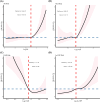The relationship between a series of inflammatory markers on the risk of heart failure in different gender groups: Analysis from NHANES 2015-2018
- PMID: 38527048
- PMCID: PMC10962816
- DOI: 10.1371/journal.pone.0296936
The relationship between a series of inflammatory markers on the risk of heart failure in different gender groups: Analysis from NHANES 2015-2018
Abstract
Background: A better understanding of the level-grade inflammation for the development and worsening of heart failure (HF) in different gender groups is an unmet need. We performed an updated analysis on the impact of a series of systemic inflammation markers on HF.
Methods: This compensatory cross-sectional study enrolled participants from the National Health and Nutrition Examination Survey (NHANES) 2015-2018. HF was based on the self-reported questions. Univariate and multivariate logistic regression were used to investigate the association between systemic immune-inflammation index (SII), high sensitivity C-reactive protein (hs-CRP), lymphocyte-to-monocyte ratio (LMR), neutrophil-to-lymphocyte ratio (NLR), platelet-to-lymphocyte ratio (PLR) and HF. For patients of different genders, P for trend was used to analyze potential linear trend relationships and the restricted cubic splines (RCS) were used to describe non-linear relationships. The additive interaction was evaluated by the relative excess risk due to interaction (RERI), attributable proportion (AP), and the synergy index (SI). The multiplicative interaction was evaluated by odds ratio (OR) and 95% confidence interval (CI) of product-term.
Results: A total of 5,830 participants from the NHANES database were divided into two groups: the HF group (n = 210) and the non-HF group (n = 5620). After gender stratification, hs-CRP (OR: 1.01, 95% CI: 1.00-1.03), SII (OR: 1.00, 95% CI: 1.00-1.01), NLR (OR: 1.22, 95% CI: 1.11-1.35) and LMR (OR: 0.79, 95% CI: 0.65-0.93) were independent meaningful factors for HF in males, there was no non-linear relationship between the three factors (SII, NLR, hs-CRP, all P for non-linear > 0.05) and the prevalence of HF, but we detected a non-linear relationship between LMR and the prevalence of HF in males (P for non-linear < 0.05). An additive interaction of hs-CRP and NLR on the risk of HF in males (RERI (OR): 0.67, 95% CI: 0.12-1.34; AP (OR): 0.14, 95% CI: 0.02-0.24; SI (OR): 1.22, 95% CI: 1.03-1.44).
Conclusions: In summary, hs-CRP, NLR, and LMR are superior meaningful markers for HF in males. SII may be a meaningful systemic inflammation warning marker for HF, which needs to be discriminated against with caution. Only detected a non-linear relationship between LMR and the prevalence of HF in males. NLR and hs-CRP may have an additive interaction in the prevalence of male HF patients. The outcome compensated for previous studies that still needed more studies for validation.
Copyright: © 2024 Cheng et al. This is an open access article distributed under the terms of the Creative Commons Attribution License, which permits unrestricted use, distribution, and reproduction in any medium, provided the original author and source are credited.
Conflict of interest statement
The authors have declared that no competing interests exist.
Figures



Similar articles
-
Inflammatory markers are associated with infertility prevalence: a cross-sectional analysis of the NHANES 2013-2020.BMC Public Health. 2024 Jan 18;24(1):221. doi: 10.1186/s12889-024-17699-4. BMC Public Health. 2024. PMID: 38238731 Free PMC article.
-
Systemic immune-inflammatory biomarkers (SII, NLR, PLR and LMR) linked to non-alcoholic fatty liver disease risk.Front Immunol. 2024 Feb 28;15:1337241. doi: 10.3389/fimmu.2024.1337241. eCollection 2024. Front Immunol. 2024. PMID: 38481995 Free PMC article.
-
Association of systemic immune biomarkers with metabolic dysfunction-associated steatotic liver disease: a cross-sectional study of NHANES 2007-2018.Front Nutr. 2024 Sep 4;11:1415484. doi: 10.3389/fnut.2024.1415484. eCollection 2024. Front Nutr. 2024. PMID: 39296508 Free PMC article.
-
Neutrophil-Lymphocyte Ratio and High Sensitivity C-Reactive Protein as Markers of Heart Failure Severity: A Study at the University of Port-Harcourt Teaching Hospital Heart Failure Clinic.West Afr J Med. 2024 May 31;41(5):562-567. West Afr J Med. 2024. PMID: 39208025
-
Systemic Inflammatory Markers for Predicting Overall Survival in Patients with Osteosarcoma: A Systematic Review and Meta-Analysis.Mediators Inflamm. 2021 Oct 21;2021:3456629. doi: 10.1155/2021/3456629. eCollection 2021. Mediators Inflamm. 2021. PMID: 34720749 Free PMC article.
Cited by
-
The levels of systemic inflammatory markers exhibit a positive correlation with the occurrence of heart failure: a cross-sectional study from NHANES.Front Cardiovasc Med. 2024 Oct 11;11:1457534. doi: 10.3389/fcvm.2024.1457534. eCollection 2024. Front Cardiovasc Med. 2024. PMID: 39465132 Free PMC article.
-
Relationship between serum albumin level and hospitalization duration following percutaneous coronary intervention for acute coronary syndrome.Sci Rep. 2024 Oct 12;14(1):23883. doi: 10.1038/s41598-024-74955-8. Sci Rep. 2024. PMID: 39396090 Free PMC article.
References
-
- Angkananard T, Inthanoo T, Sricholwattana S, Rattanajaruskul N, Wongsoasu A, Roongsangmanoon W. The Predictive role of Neutrophil-to-Lymphocyte Ratio (NLR) and Mean Platelet Volume-to-Lymphocyte Ratio (MPVLR) for Cardiovascular Events in Adult Patients with Acute Heart Failure. Mediators Inflamm. 2021;2021:6889733. Epub 2021/10/22. doi: 10.1155/2021/6889733 . - DOI - PMC - PubMed
MeSH terms
Substances
LinkOut - more resources
Full Text Sources
Medical
Research Materials
Miscellaneous

